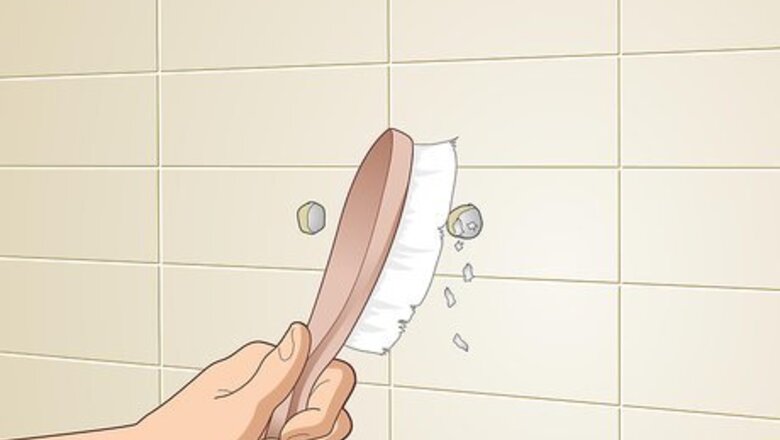
views
Patching the Hole
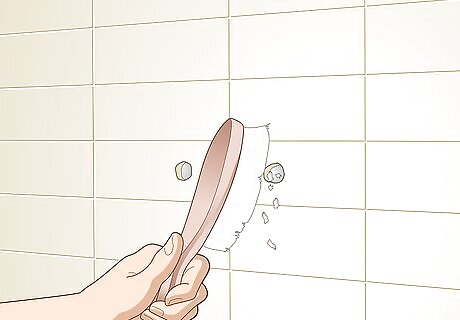
Wipe the area around the hole and brush away any loose debris. Grab a clean, dry brush and run it back and forth over the tile to knock any dirt or dust off. Then, grab a damp towel and wipe the opening and surrounding area with the cloth. Let the tile air dry for 10-20 minutes before brushing it again with your dry brush again. Patching the tile won’t make it look perfect, but it’ll be close enough that guests won’t the difference if they aren’t looking carefully. You can always replace the tile if you want a perfect fix. This will work for any hole smaller than 3–4 inches (7.6–10.2 cm). It will also work with cracks smaller than 1–2 inches (2.5–5.1 cm). Anything bigger than this will require new tile.
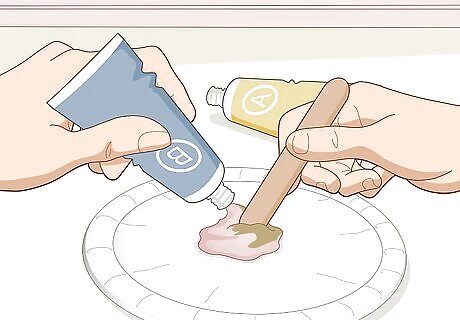
Mix an auto body filler on a paper plate to activate it. Grab a 2-part auto body filler online or from your local auto supply store. Pour out enough putty material on a paper plate to fill in your hole. Then, follow the manufacturer’s instructions to mix the activating hardener into the putty and activate it. Typically, you squirt a small amount of hardener into the putty material and move it around with a chisel until the color and texture is uniform. Auto body filler is used to patch dents and holes in vehicles, but it has the perfect texture and holding power for tile. If you can, get an auto body filler kit with paints to match the color of your tile. You can always use acrylic or porcelain paint, but the paint that comes with these kits will match the texture of your tile pretty well.
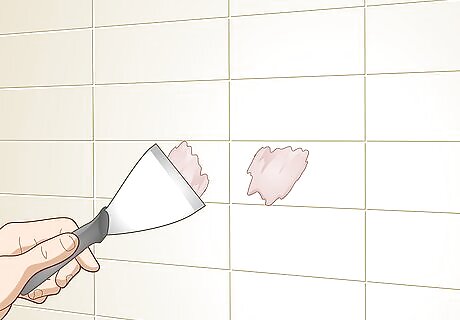
Scoop up filler with a putty knife and drag it over the hole to fill it in. Dip the putty knife into the filler to load the blade up. Hold the blade at a 45-degree angle to the hole and rub the filler into the hole. Push the filler into the hole using the flat side of the putty knife. Reload your putty knife as needed and continue scooping filler into the opening until the hole is fully covered in a thick layer of filler. Feel free to use a large amount of the filler. You’re going to scrape the extra filler off, so you’re not risking anything by using a lot of it. You don’t actually need to fill the hole in all the way. The filler will harden in the opening of the hole just fine without reaching the back of the opening.
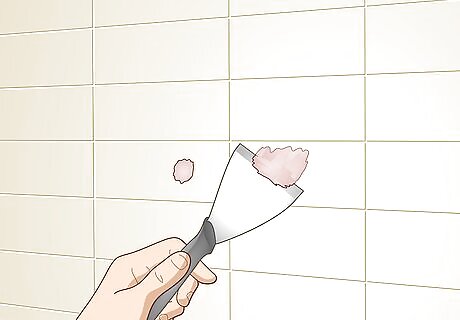
Scrape the putty knife over the tile to smooth the filler down. Use the sharp blade on the putty knife to even out the filler and scrape the excess up by dragging the blade against the tile at a 35- to 45-degree angle. Continue scooping and scraping until the filler is completely covering the hole and it’s a little thicker than the surrounding tile. The filler must be thicker than the surface of the surrounding tile for this to work. If it isn’t, there will be an indentation in the middle of the patch.
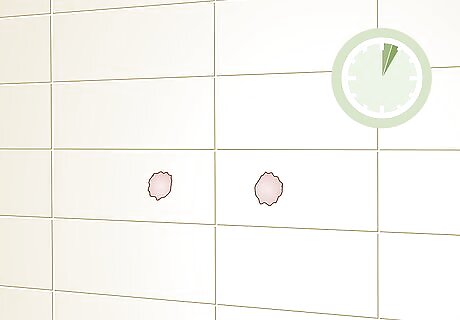
Wait 3-5 minutes to give the filler time to harden a little. The filler will completely dry after 10 minutes, but you need it to be a little firmer to file the excess off. Hang out for 3-5 minutes to wait for the filler to partially harden. You can touch an edge of the filler with your fingertip to see if it’s hard enough to scrape off if you’d like. If there’s a little give but the filler is kind of hard and doesn’t come off on your finger, it’s ready to scrape down.
Sanding and Painting the Patch
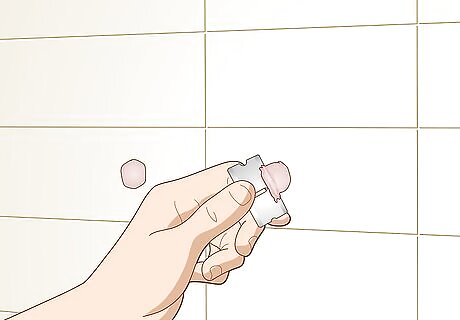
Drag a razor blade over the hole to scrape away excess filler. Grab a clean razor blade. Hold the razor blade at a 35-degree angle to the tile and drag it back and forth over the filler. Work the blade over the edges and work your way towards the middle of the hole. Continue doing this until you’ve scraped the excess filler off to make it flush with your tile. You don’t need to press very hard into the tile to get the filler off.
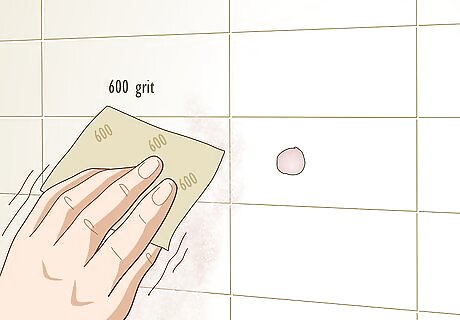
Sand the surface of the filler with 600-grit sandpaper to make it flush. Grab a sheet of 600-grit sandpaper and smooth over the patch using gentle circular motions. Sand the surface for 15-25 seconds until the texture of the filler is smooth and even. Avoid getting the sandpaper on the undamaged tile surrounding the filler. If you do accidentally scrape the tile surrounding the hole, you probably don’t need to worry. The fine sandpaper probably isn’t coarse enough to damage the ceramic.
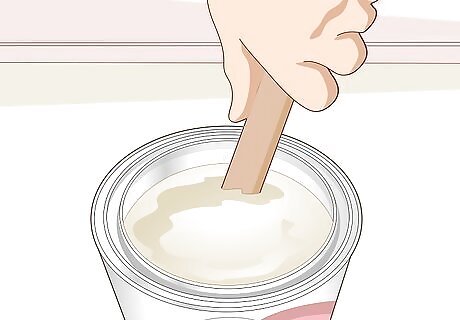
Mix paints from a porcelain repair kit to create a matching color for the tile. If paint came with your filler, use that instead. Otherwise, pick up a porcelain touch-up kit at your local hardware store. Combine the individual colors on a paper plate and mix them up using a paint brush until you develop a shade that closely resembles the surrounding tile.Variation: If your tile isn’t glazed and it has a kind of matte finish, use regular acrylic paint instead. The texture of acrylic paint will be closer to your tile than the porcelain touch-up paint. If your tile is white or black, you don’t need to mix anything. Just use the white or black that came with the kit.
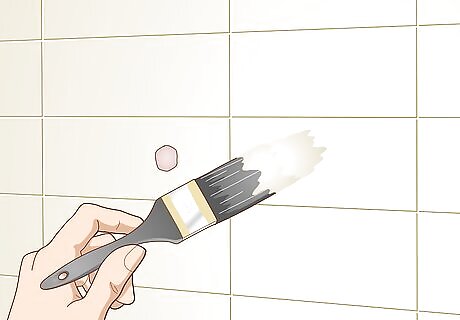
Paint over the patch to blend it into the tile and let it dry for 24 hours. Gently wipe the surface of the patch with a dry cloth to remove any dust from the sanding. Dip your brush into the paint and apply it to the patch. Use straight brush strokes and reload it with paint whenever it dries out. Cover the seam where the filler meets the surrounding tile to blend it into the tile. Once you’ve covered the filler, wait at least 24 hours for the paint to completely dry. If you used acrylic paint, sand the surface after it dries if you want to remove the brush marks. These marks won’t be particularly noticeable with the porcelain or auto filler paint, but you can do this with these paints as well.
Hiding the Hole
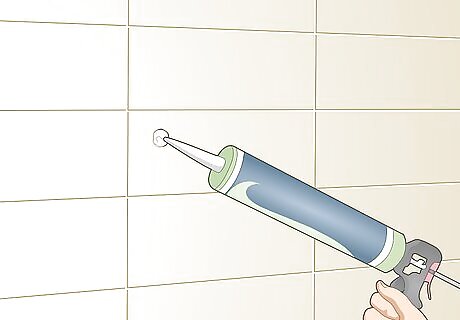
Fill the hole in with matching silicone caulk if it’s really small. If the hole is smaller than ⁄2 in (1.3 cm), you can quickly fill in the hole with some caulk to just keep things simple. Get a tube of caulk in a color that closely matches the tile and pump a few dollops of caulk into the hole. Smooth it out with your finger and use a clean cloth to wipe the excess caulk away. The caulk will be noticeable on the wall, but it won’t look nearly as bad a hole. For a really minor gap, most people aren’t going to notice the caulk unless the color is completely off. You can also use a clear caulk and paint it if you’d like.
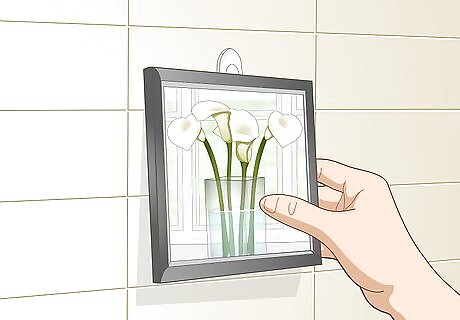
Hang a photo or painting over the hole to cover it entirely. Find a photograph or lightweight canvas that will cover the hole. Then, place an adhesive command hook or strip of mounting tape above the hole. Hang a photo or small painting on the hook or mounting tape and let it hang over the hole to obscure it completely. You can certainly drill into the tile to hang a heavier painting if you prefer, but this is a lot more work than using mounting tape or command hooks. A framed canvas or mirror will be too heavy to do this. If you’re hanging a lightweight canvas, a command hook will be more reliable than mounting tape.
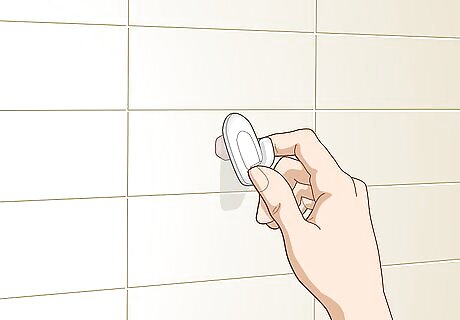
Put a command hook over the hole to hang something up. If it’s a small hole on your kitchen backsplash or bathroom wall, get a command hook. Peel off the adhesive back and press it over the hole. Then, hang a towel, washcloth, or oven mitt from the hook. This is a great way to turn an unsightly hole into a useful place to hang something you always need. Don’t do this if there are cracks radiating away from the hole. Over time, the command hook will pull on the tile and make these cracks worse.
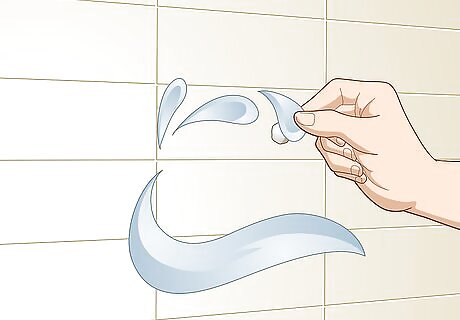
Use tile stickers to cover the hole and create a pattern on the wall. You’ll probably need to buy these online, but there are ceramic stickers designed to cover tiles with a piece of adhesive art. Measure the size of your tile and go online to look for a design that will match the size of your tile. When you get the stickers, peel one off and carefully stick it over the damaged tile. Use a credit card to flatten out any air bubbles.Tip: Covering the single tile will look a little odd. You can do this if you want, but it may look better if you use multiple stickers to put a pattern on the wall. A simple horizontal stripe is a great option, but you can also create vertical columns, or make a checkered pattern.




















Comments
0 comment